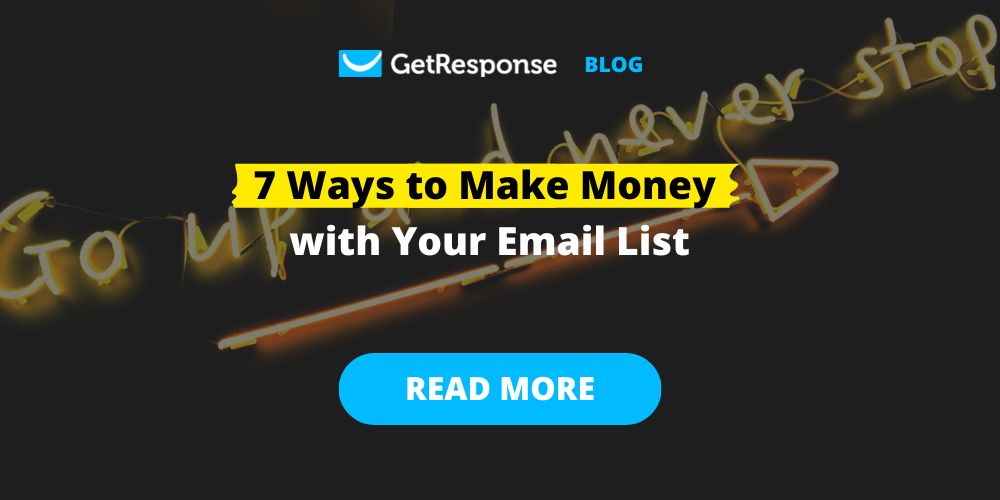I’m sure you’ve heard the expression – “money is in the list.”
And it’s true. Email marketing has a tremendous ROI, and we’ve got multiple case studies that prove it.
What’s also true is that there isn’t just one way to make money with email marketing. There are many. And I’m about to share them with you.
Whether you’re a creator, affiliate marketer, coach, or all-around marketer, you’ll want to stick around. These seven tactics are about to turn your email marketing program into a growing revenue source.
💡 Did you know? GetResponse not only can help you run your email campaigns more effectively, but it can also help you generate income! By joining our affiliate program, you can earn $100 or 33% lifetime recurring commissions for every referred customer. Join the program today!
How to make money with email list: 7 actionable ways
Before going over how you can make money with email, I want to make a disclaimer.
Even though email marketing boasts an impressive ROI of 3,800%, it is a long-term game. Building an engaged email audience takes time and effort, and that’s only a part of the equation.
So, if you ever hear someone promising that you’ll generate an extra $5k in income from email just after 30 days of work, simply ignore them.
With that out of the way, let me take you through the key ways of making money with email marketing.
1. Use affiliate marketing and promote other people’s products or services
One of the first associations people make about making money online comes down to joining a lucrative affiliate program.
The dynamics are pretty straightforward—you select a brand with an affiliate program, sign up for it, and start promoting its products or services to your email subscribers. For every purchase made through your affiliate link, you receive a commission.
How affiliate marketing works
Let’s say you’re a personal finance blogger and online coach. The most fundamental way for you to capitalize on your position as a financial expert is to tap into the affiliate products offered by FinTech software such as eToro, Binance, or Robinhood:
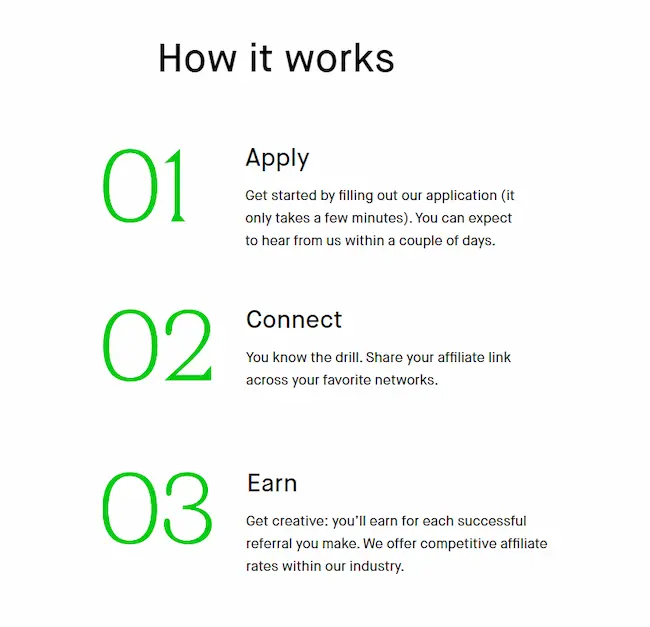 How a Fintech affiliate marketing program works
How a Fintech affiliate marketing program works
Another option in this niche is to partner with banks offering an enticing commission for promoting their products. There are plenty of them out there — for example, American Express pays up to $200 per sale.
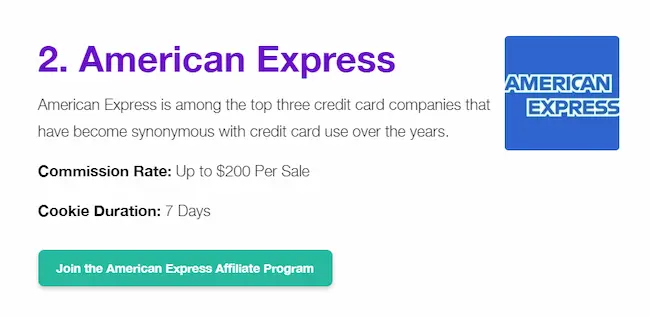 American Express affiliate program details
American Express affiliate program details
How does affiliate marketing work?
Before we get into the technical side of this marketing channel, let’s say it out loud — the key to success is to promote products or services that meet both fundamental requirements:
- They are trustworthy enough that you can sign your own name to them. Don’t get tempted by a high commission, and spread the word about a scammy product. If you lose your credibility as a solopreneur, you lose your business.
- You have knowledge and experience about a specific niche, so you can leverage your street credit to promote products connected to your expertise.
Speaking of the second aspect — Michał Szafrański, one of the most famous Polish financial bloggers, got on the media’s front pages when he earned 70,000 PLN (currently over $16K) on one blog article which was connected to one bank’s affiliate program! Super crazy! And it wouldn’t be possible if it wasn’t for his personal brand and huge credibility.
That said, let’s look at the technical part:
- You select your merchants that offer enticing affiliate products that match your business scope. (If you’re still looking, check out our curated list of best affiliate marketing programs.)
- Sign in to the merchant’s program and get a unique affiliate link.
- You start promoting the product among your audience. As this article is solely about email marketing, you’re leveraging email subscribers, but there are other ways to promote your affiliate links.
- Both merchants and affiliates can monitor the performance of those email campaigns by tracking impressions, clicks, and sales.
- You get paid for every objective based on the commission — a conversion, a lead, a sale, and an app install.
Affiliate products are a proven way to generate income, and if you handle it well, it can be super easy (injecting an affiliate link in your email content) and profitable.
For instance, GetResponse’s affiliate program offers 33 percent recurring or a one-off $100 commission — what a great way to secure a passive income!
👉 Learn more with our affiliate marketing for beginners guide and how to build an email list for affiliate marketing.
2. Include sponsored content or advertising in your emails
Another way to make money with email marketing is to introduce sponsored content and advertising into your email campaigns.
Those commercial tactics are an excellent fit for email marketers who have been on the scene for a while and managed to grow their mailing lists to a number of at least 2,500 subscribers.
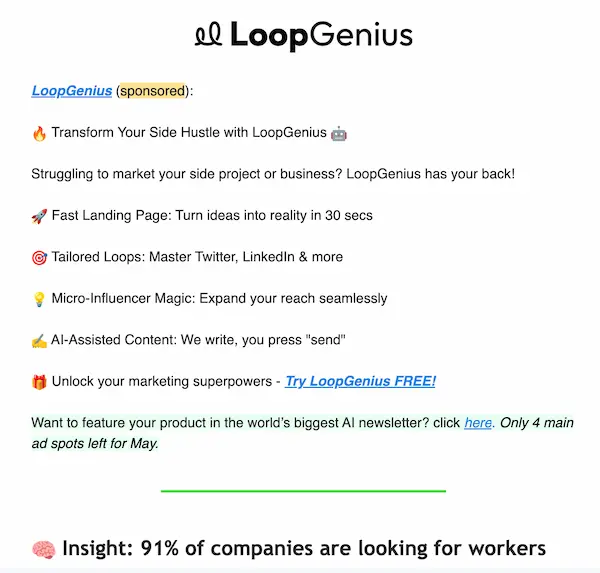 Example of a sponsored ad inside a newsletter
Example of a sponsored ad inside a newsletter
Naturally, the bigger and more engaged your email list is, the better. Only this way you will become an attractive asset for potential advertisers.
There’s another reason why hundreds of folks on your email list won’t be enough, but thousands will make a difference. It’s called CPM (Cost per thousand impressions)—a unit that will help you and your advertiser set the prices for a banner displayed in your newsletters.
How about solo ads?
A solo ad works like this: advertisers contact email list owners and purchase a placement in their email. Simply put, a brand buys a dedicated email and taps into that owner’s existing email audience.
Even though solo ads don’t have the best reputation from the advertiser’s point of view, it can be a different story when you run a thriving online business and have the capability of providing solo ads service to advertisers.
To make it work, make sure that:
- sponsored emails you send to your subscribers align with your audience’s interests
- you don’t follow spammy practices, and your email list is 100% legit
- you don’t overuse solo ads and trigger your email subscribers to opt out of your mailing list.
Check out this detailed guide about solo ads and consider whether they’re a good idea for your online business.
Monetize your newsletter with sponsored content
Brands are looking for ways to promote their products through channels other than paid social media ads and Google Display Network.
That’s why, once your newsletters become a powerful medium, brands that find your audience overlaps with their buyer persona will be open to partnering with you.
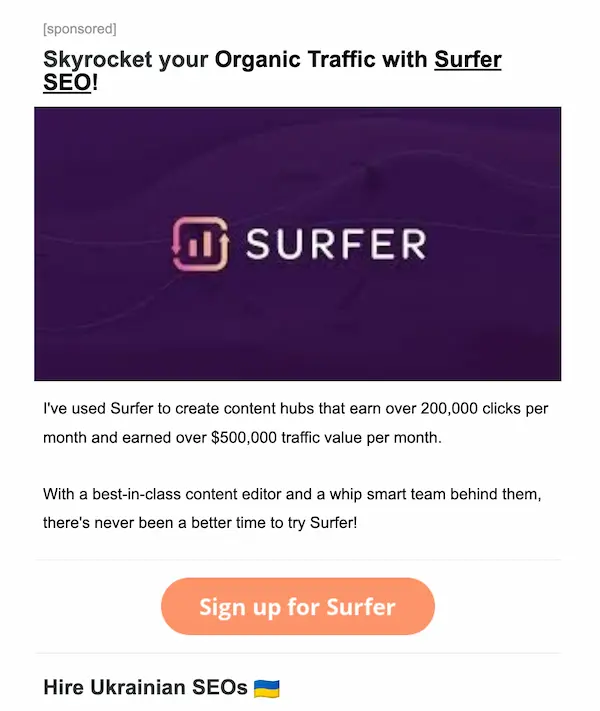 Example of a sponsored ad in the SEO Notebook newsletter
Example of a sponsored ad in the SEO Notebook newsletter
There are three main ways of sponsoring your newsletter:
- Selling classified ads — smaller ads sprinkled all over your newsletter.
- Dedicated emails — one email = one sponsored content
- Sponsored emails — which means a more prominent ad placement in your newsletter
Once you decide which format you will implement, it’s time to think about your pricing. You can set up a flat fee, like $500, for an ad placement. Or, you can opt for a CPM (CPM = Cost of an ad in email send / Number of email subscribers) x 1,000) model.
From there, it’s time to reach out to potential buyers with your sponsored newsletter offer or sign up for marketplaces like Paved, Swapstack, Whosponsorsstuff, Sponsorgap, and Passionfruit.
Pro tip: Don’t rest on your laurels and wait for potential sponsors to contact you. Think about the brands that would best fit your audience and proactively reach out to them with your offer. Make sure to provide detailed information about your audience size, engagement, types of ad units offered, and projected number of clicks the sponsor could count on.
The other option is to pitch your email recipients with your sponsored offer if you know that decision-makers already subscribe to you (which you can check in an email marketing platform like GetResponse). Here’s how Erin Balsa from Haus of Bold does it:
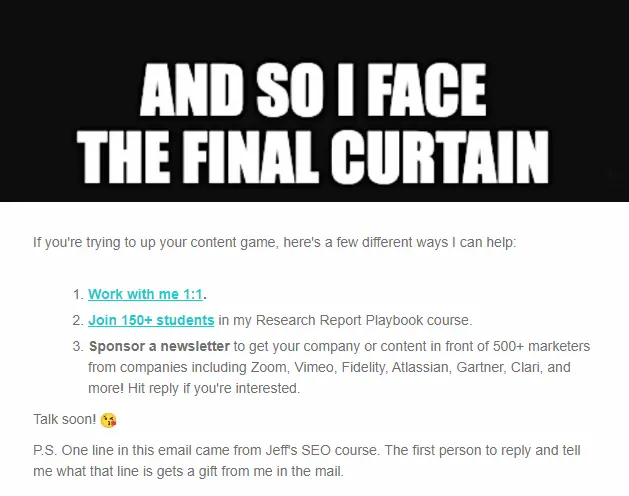 How Erin Balsa pitches sponsored offers in her newsletter
How Erin Balsa pitches sponsored offers in her newsletter
3. Create a tripwire offer
OK, another method of generating more money through email marketing is tripwire offers. While the name of that technique is not the most fortunate in the world, it’s pretty standard among email marketers.
Implementing a tripwire means offering your new subscribers a low-priced product or service. Setting the entry threshold low (as the tripwire) increases the chances of getting more people to purchase.
“OK, it costs only $5, no biggie” — and they’re in! OK, it doesn’t have to be that cheap. Let’s say you’re an online life coach, and you’re offering a bargain deal of $30 for the first online strategy session. As long as you deliver quality after closing that sale, you open an avenue to pitch your more expensive services.
In practice, it can mean creating a landing page with a curated offer and sending an upsell email after finalizing the first deal.
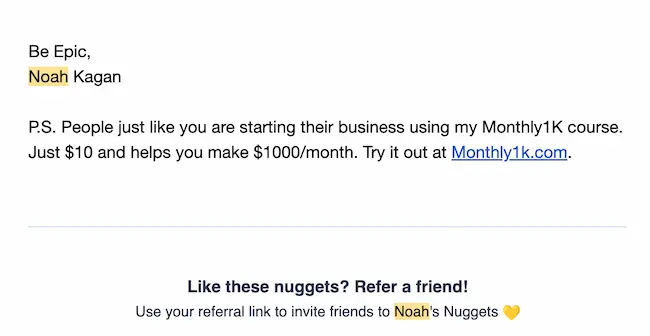 Example of a tripwire offer from Noah Kagan
Example of a tripwire offer from Noah Kagan
4. Sell your own product or service
OK, affiliate marketing and advertising can help you earn money. In some cases, those results can be impressive.
However high the affiliate commission is, it’s still a percentage. You get 20, 30, or 40% of conversions or sales if you’re lucky.
By selling your products or services, you can make money on a scale that will substantially drive your online business forward.
You own it — the 100% goes into your pocket without sharing that with a sponsorship marketplace or a merchant.
How can you pull this off?
At your service
Let’s start with offering a service. If you’re a consultant, an online coach, or a freelance marketer, you can market your services to your email subscribers. Your email list is your potential customers.
As long as you provide them value for free through your email marketing program, at some stage, they will naturally go down the sales funnel and be more prone to try your offer.
Create your own product
Another one is a digital product. It can be a paid ebook or a package of coaching sessions. The rule of thumb would be the same as with your services.
Your product needs to solve pains and generate gains for your target audience. It has to be relevant to them!
We’re in the middle of an AI revolution. And for you, as a content creator, it’s a massive opportunity because, with ChatGPT4, you can now develop applications, Chrome extensions, mobile games, and other digital products without an army of software developers and designers!
And how to know if your audience will be ready to purchase your product?
Use newsletters and autoresponders to survey your subscribers and get their opinion first. The best way to market any product is to learn what your buyers need.
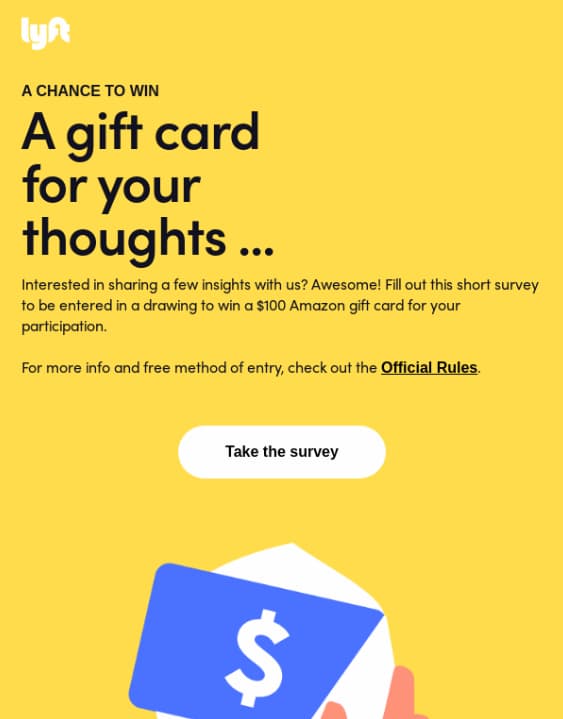 Lift survey email offering a $100 Amazon gift card for filling out a survey
Lift survey email offering a $100 Amazon gift card for filling out a survey
5. Create a paid newsletter
This part might be tricky, especially if you have just started growing your email list. You can say, “I’m struggling to have people opt into my email list for free, so how am I supposed to get them to pay me for it?”
And you’re absolutely right. It’s a real challenge at the early growth stage. It will take some time, but by providing high-end value to your readers, you will reach the moment to:
- Transform your free email sequence into a paid newsletter
- Create a premium version of your regular newsletter with exclusive content you won’t share anywhere else.
Before you go full-scale, try to test the waters first. Voice of customer data is essential here. Email marketing allows you to gather feedback from your email subscribers. Ask them:
- Would they pay you if you introduced a paid newsletter
- What type of content would be worth paying for (in their opinion)
- How much would they pay you
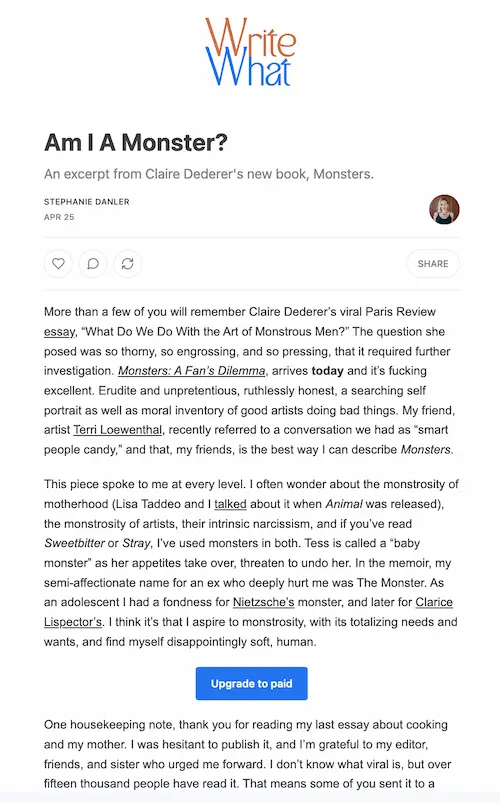 Example of a free newsletter motivating you to upgrade to a paid version
Example of a free newsletter motivating you to upgrade to a paid version
Looking for inspiration? There are several thriving paid newsletters out there, each of them dedicated to a specific niche:
- Stratechery Plus – a premium version of the Stratechery newsletter about tech and business,
- STAT+ – in-depth coverage on biopharma, health tech, and science,
- The Browser – with quality, curated stories.
Heads up 💡 We’re about to launch our own Content Monetization Platform that’ll simplify the process of creating paid newsletters, courses, webinars, and everything else that creators need to do. Wanna know more? Join the waitlist today!
6. Create a paid course
Earlier, I mentioned crafting a digital product to make money with email marketing. Creating a paid online course is one of the most popular and profitable digital products used by solopreneurs.
Sharing tips and tricks and leading thoughts through a free or paid newsletter is one thing. Teaching your subscribers interested in your expertise, new skills, and workflows is another.
To create a paid course, you’ll need to go back to the drawing board and list your audience’s pain points. Then, create a step-by-step process to overcome those challenges.
Once you have the idea for your online course, you need to:
- Break down the structure into lessons, videos, worksheets, and quizzes
- Create a landing page with the signup form
- Optimize your landing page for specific keywords
- Run a successful email marketing campaign backed up by paid social ads to drive traffic to your page.
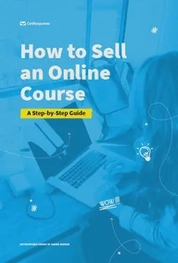
How to sell an online course
Do you enjoy creating educational courses and want to turn your knowledge into a profitable business? Follow these simple steps and start selling your first online course today!
Download guide
Sell your online course with a conversion funnel
Over the past few years, the booming popularity of e-learning platforms like Udemy or Coursera has translated into proven ways to make money online for thousands of coaches and trainers.
However, the entire process of managing and marketing an online course can scare many people away. The good news is — that there is a way to manage it from top to bottom through GetResponse’s conversion funnel.
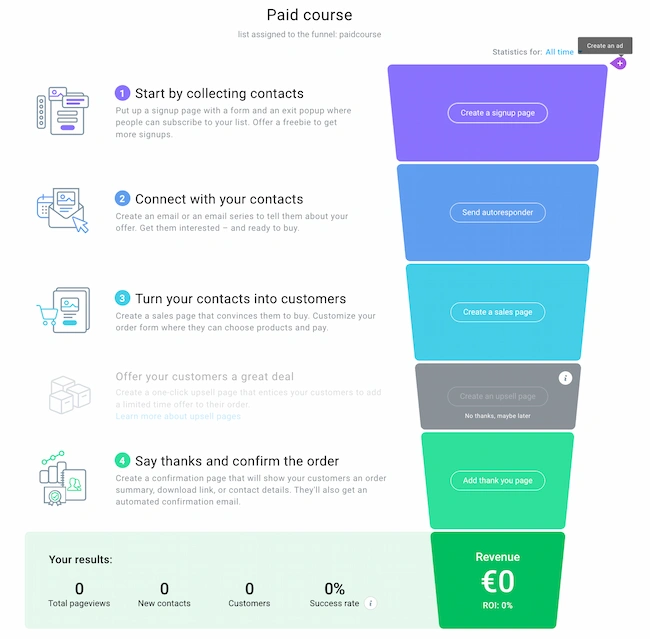 Selling a paid course through GetResponse Conversion Funnels
Selling a paid course through GetResponse Conversion Funnels
- First, behind every successful product campaign, there is website traffic. And the fastest way to trigger that is through paid advertising campaigns. The great part about it is that you don’t have to jump from one ad manager to another. You can orchestrate your paid ads from our conversion funnel’s first stage.
- The next stage in the conversion funnel is converting your website visitors into leads. If your landing page has some gated content, creating a sign-up form will do the trick. If, on the other hand, your landing page is a blog post, then coming up with an exit popup is the tool that can persuade people to leave you their emails.
- People who got interested enough signed up for your email list – yay! At this funnel stage, it’s time for email marketing to work its magic! Starting with a welcome email, you can craft your entire email campaign to nurture your leads with valuable content and to build a ground for pitching them with paid courses through an upsell email.
- After nurturing your leads with email automation, it’s time to show them how much more profit they can gain by signing up for your paid course. Create content on your website with your course outline, structure, and benefits. With the right message, you can convert your subscribers into paid customers.
- It might not always be the case for you as a course creator, but the conversion funnel allows you to upsell your trainees with premium time-limited offers.
- And the most enjoyable part of your digital business journey is connecting to your chosen payment system and observing how much money you earn on sharing your know-how and skills with your email subscribers!
How can you customize your funnel
But the best part of conversion funnels for teaching and training online is that you can build that architecture of actions and stages the way you want!
Examples? Of course!
Check this video where Ian Cleary, Founder of Razor Social, breaks down the process of building their funnel for selling an online course.
Their approach was a bit different:
- They started with a landing page
- Where they collected sign-ups with a form and an exit pop-up
- From where they reached out to their new subscribers with an autoresponder
- Sending people to the sales page.
- Which was connected to the payment method (Stripe)
- With a confirmation page after that
- And, of course, the final metric at the bottom of the funnel – how much money they earned.
Another interesting case comes from Alex Terrier. This jazz musician was widely successful in selling his online music course with the conversion funnel. Only during the first 30 days of his campaign he managed to land:
- 1350 unique landing page visitors
- 253 new subscribers
- 502 unique sales page visitors
His secret sauce? Offering free and high-quality content to hook aspiring musicians.
7. Run paid webinars
And there comes our last email monetization method — running webinars. Conducting online events can serve multiple purposes.
For instance, free webinars are a perfect way to generate leads and nurture existing email subscribers with additional helpful content.
Webinar tools such as polls and surveys, chat, and Q&A enable you to interact with your audience and know them better. This knowledge can help you refine your messaging when you are all set to create content — for a blog post or an ebook.
But paid webinars are a different story. It’s not about capturing leads. Running webinars with an entry fee means selling advanced knowledge and insights to people who want to upgrade their skill sets or learn something super valuable that is not available for free elsewhere.
How much money can you make with paid online conferences and training sessions? Here are some examples from the State of Online Events 2022:
- Conference for coaching experts: creating partnerships: 881 tickets sold, 20,602 EUR earned
- Training for psychotherapists and psychologists (32 events): 7103 tickets sold, 686 808 EUR earned
- Webinar to improve the therapists’ skills: 580 tickets sold, 12,309 EUR earned
Impressed? No wonder! Let’s sneak a peek at how to run paid webinars!
How to run a paid webinar
Follow this step-by-step workflow:
- Create content for your online events: a script, a slide deck, and other media such as videos, quizzes, and surveys.
- Invite a co-host if necessary.
- Create a webinar with a meaningful name, date, and duration.
- Set up your price for an entrance ticket.
- Enable the automatic recording to repurpose your live event as an on-demand webinar that will make money long after you wave “goodbye” to your attendees.
- Send invitations to your subscribers.
- Promote the event on your social media – organically and with paid ads.
- Run the event and keep your audience engaged.
- Follow up with your attendees with additional content and possibly cross-selling your other digital products.
Pro tip: You can orchestrate everything in GetResponse – your webinar, an email campaign, and paid ads on Facebook or Instagram.
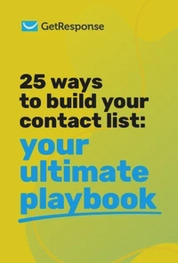
25 ways to build your contact list
We’ve compiled a list of 25 tried-and-tested tactics for the success of your future campaigns.
Download guide
Start making money with email marketing!
Even without a big marketing team or a dedicated email specialist, email marketing has a wide array of options to make money — from promoting affiliate products, through running a paid newsletter, to implementing advertising in your emails.
Another strategy is to pitch your services to your subscribers and sell products, such as ebooks, templates, workflows, training sessions, online courses, and paid webinars.
The critical point is consistently delivering high-quality and value for your target audience. Once you look after this part, you can experiment with different ways to make money.
And finally, to start implementing your revenue-generating program, you need a solid email service provider!
And GetResponse is the one that will help you keep everything under one roof! Try all the features for free for the next 30 days.

